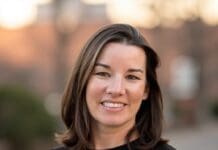By Raya Pruner
 In 1900, Frank M. Chapman of the freshly formed Audubon Society proposed a new holiday tradition that would promote conservation by counting, rather than hunting, birds on Christmas Day. Then, he called it the “Christmas Bird Census” and that first year managed 25 counts thanks to the efforts of 27 focused birders (they counted about 90 species that first year). Over the years, this bird census has come to be known as the Christmas Bird Count (CBC), and it’s the nation’s longest-running community science bird project. Over the past century, these bird counts have helped biologists, researchers, wildlife agencies and avid birders study bird populations across North America. In fact, the idea of an annual bird count has spread and now takes place in over 20 countries across the Western Hemisphere including far-flung locales like Saipan and Guam to the west, and Paraguay to the south. Audubon maintains an interactive map with all the different CBC locations and contact for each here: https://audubon.maps.arcgis.com/apps/View/index.html?appid=ac275eeb01434cedb1c5dcd0fd3fc7b4C
In 1900, Frank M. Chapman of the freshly formed Audubon Society proposed a new holiday tradition that would promote conservation by counting, rather than hunting, birds on Christmas Day. Then, he called it the “Christmas Bird Census” and that first year managed 25 counts thanks to the efforts of 27 focused birders (they counted about 90 species that first year). Over the years, this bird census has come to be known as the Christmas Bird Count (CBC), and it’s the nation’s longest-running community science bird project. Over the past century, these bird counts have helped biologists, researchers, wildlife agencies and avid birders study bird populations across North America. In fact, the idea of an annual bird count has spread and now takes place in over 20 countries across the Western Hemisphere including far-flung locales like Saipan and Guam to the west, and Paraguay to the south. Audubon maintains an interactive map with all the different CBC locations and contact for each here: https://audubon.maps.arcgis.com/apps/View/index.html?appid=ac275eeb01434cedb1c5dcd0fd3fc7b4C
Closer to home, Bay County boasts a 58-year participation record as of 2021 (helpful hint Bay County residents: a pair of binoculars makes an excellent Christmas gift).

So what exactly is a bird count? The CBC is an early-winter bird census where thousands of volunteers that make up different “circles” go out between December 14 to January 5 every year. Each circle, like Bay County, will choose a single calendar day within those dates to count birds. Count volunteers follow specified routes through a designated 15-mile diameter circle, counting every bird they see or hear all day. However, the count is not just a species tally—all birds are counted all day, giving an indication of the total number of birds in the circle that day.
Now in its second century, the CBC has evolved into more than a seasonal tradition. The CBC data represents one of the only conservation tools available for assessing the long-term trends in bird populations of North America. To date, over 300 peer-reviewed articles have resulted from use of CBC data. It was also used as a basis for Audubon’s 2014 report on the impact changing global temperatures are having on bird populations (you can see this fascinating report at www.audubon.org/climate/survivalbydegrees) and was instrumental in the collaborative development of the report by the North American Bird Conservation Initiative, and U.S. Fish & Wildlife Service (learn more at https://archive.stateofthebirds.org/state-of-the-birds-2009-report).
How to Participate:
CBC Count Day for Bay County is December 18, 2021. This year, we plan to continue the Bay County tradition but with some modifications to support a COVID-19 safe and socially distanced CBC. We look forward to your participation in the 122nd CBC, but we also urge you to prioritize your safety and the safety of others when making your decision.
Birders of all skill levels can volunteer in the CBC. If you are a beginning birder, we can pair you with local experts and if your home is within the boundaries of a CBC circle, then you can stay at home and report the birds that visit your feeder or yard on count day as long as you have made prior arrangements. Hot bird tip: if you’re just getting into birding, the free Audubon Guide to Birds in the app store is a great resource, as is Merlin Bird ID by Cornell Lab, part of Cornell University; recently, Merlin has added a Sound ID feature so you can identify birds near you based off their tweets. Another favorite is iBird Pro Guide to Birds, although that one isn’t free.
If you, or someone you know, would like to participate or have questions, contact Raya Pruner or Marvin Friel: Raya.pruner@gmail.com or marvin.bojo.friel@gmail.com. We can answer any questions you may have and assign you to a birding team! You must be part of a team to participate and/or make arrangements in advance to watch your feeder or yard.
A post-count ZOOM meeting is planned for 7 p.m., on the evening of Count Day (December 18, 2021). We will explore the day’s count results together and the day’s highlights, including the biggest finds of the day.
Details will be provided to all participants in advance of count day. Information on all available count circles can be found www.Audubon.org.





















































